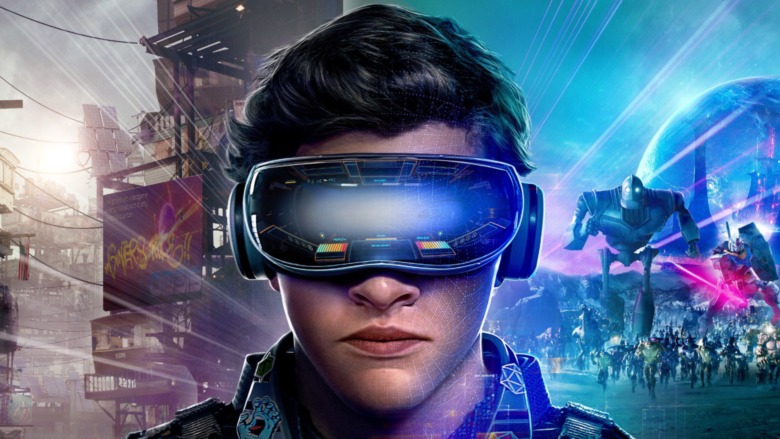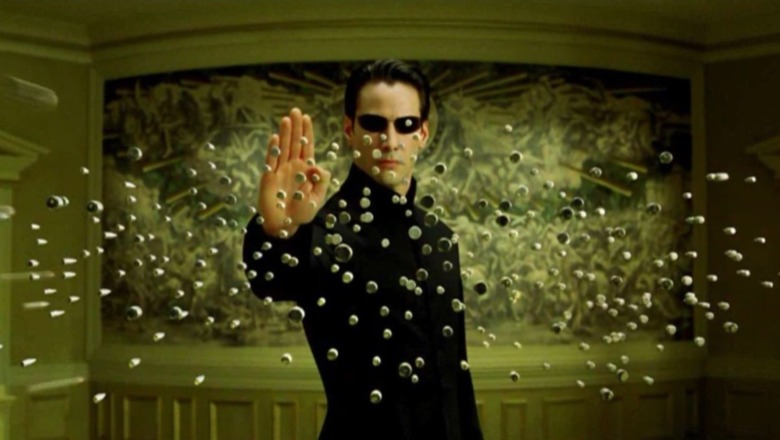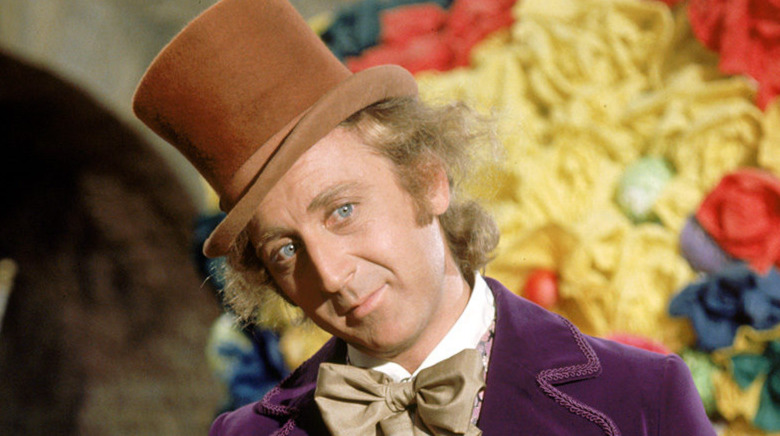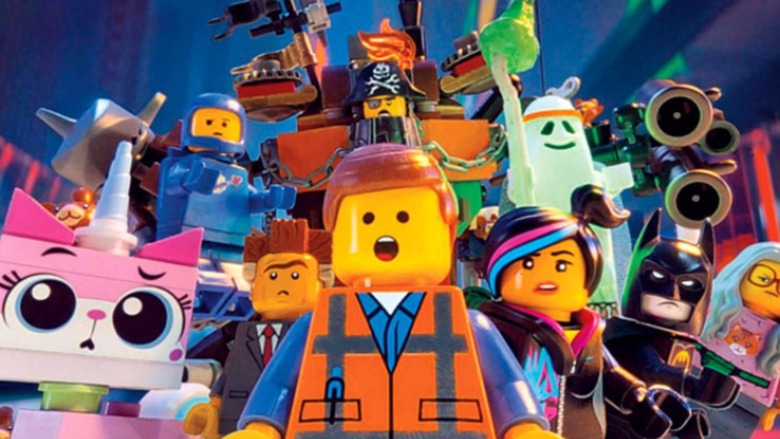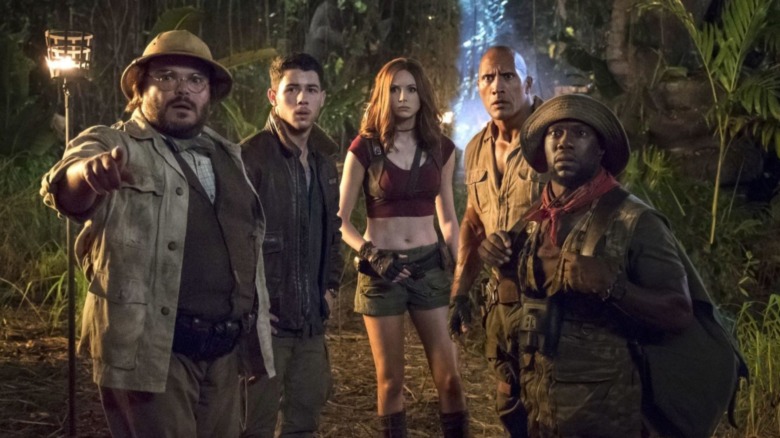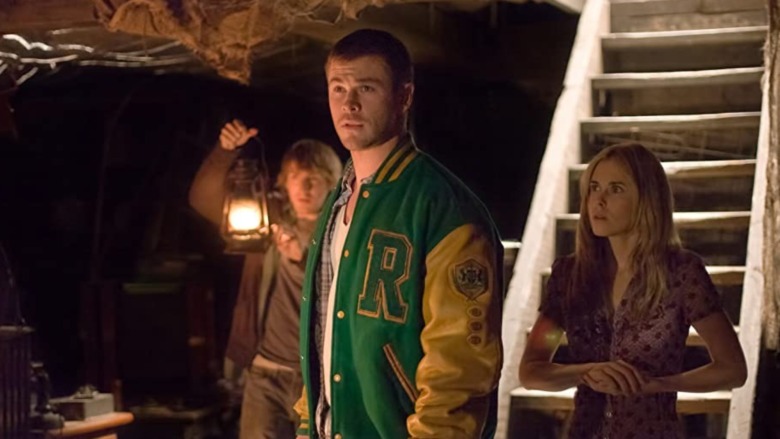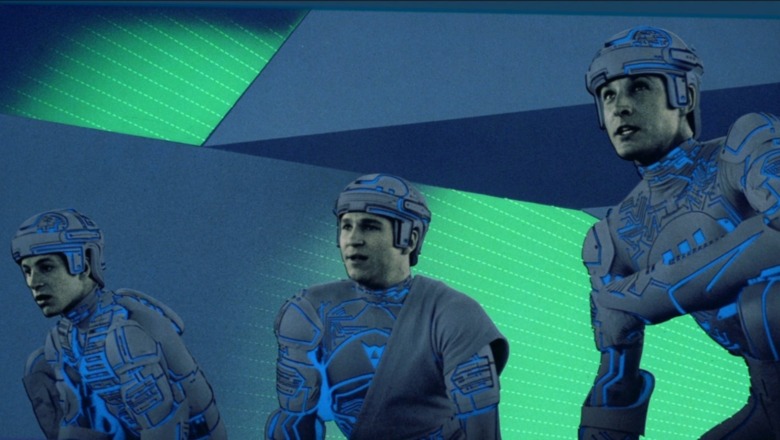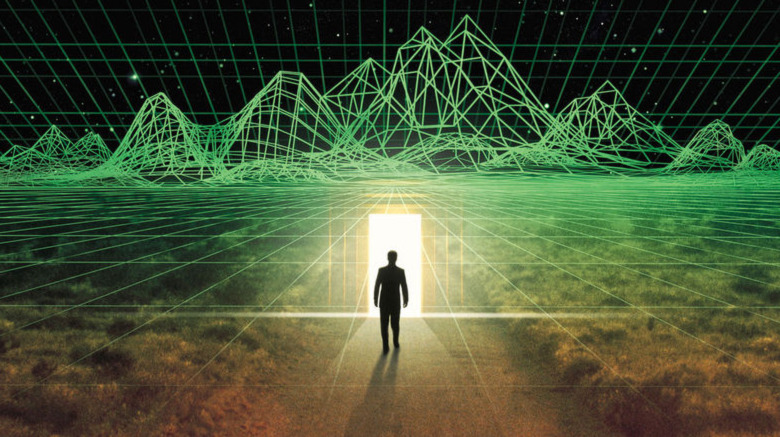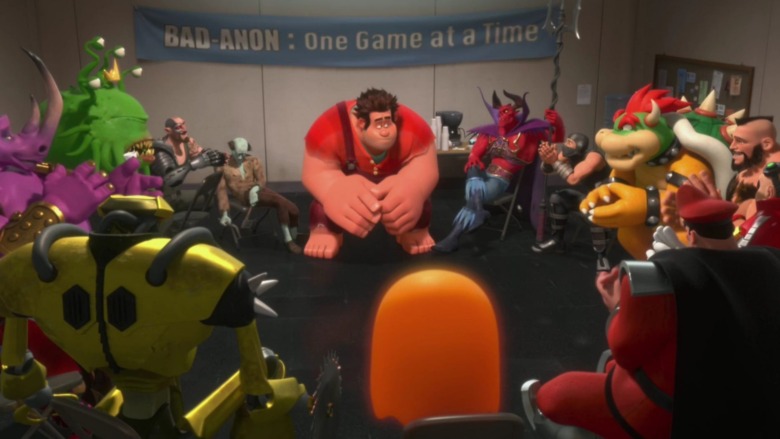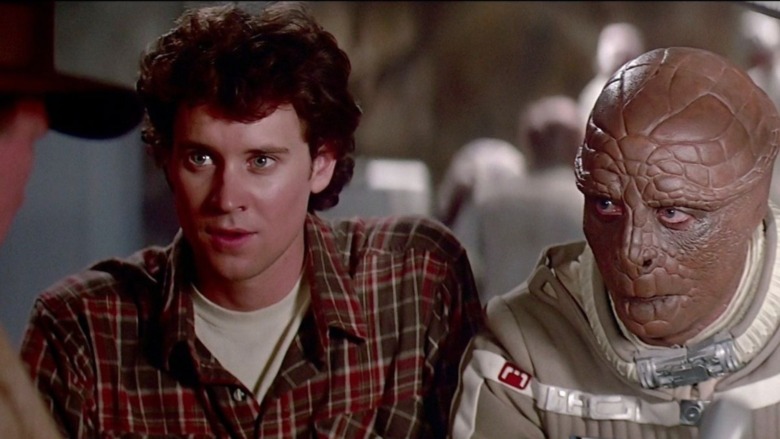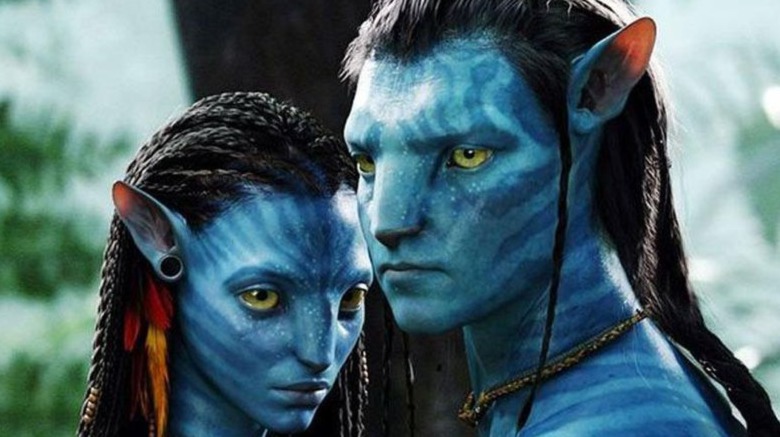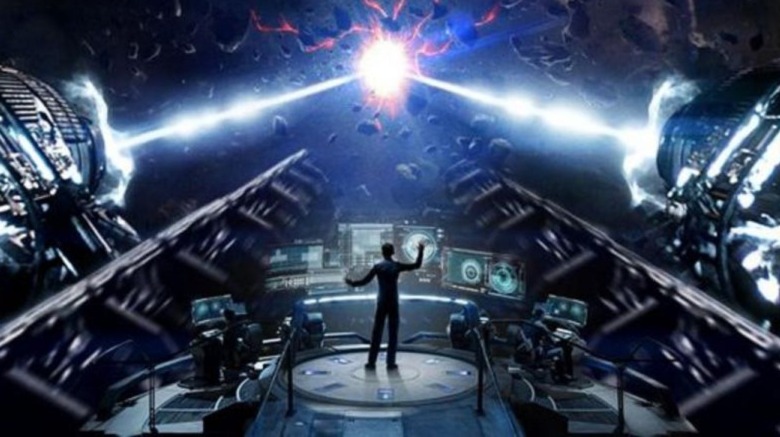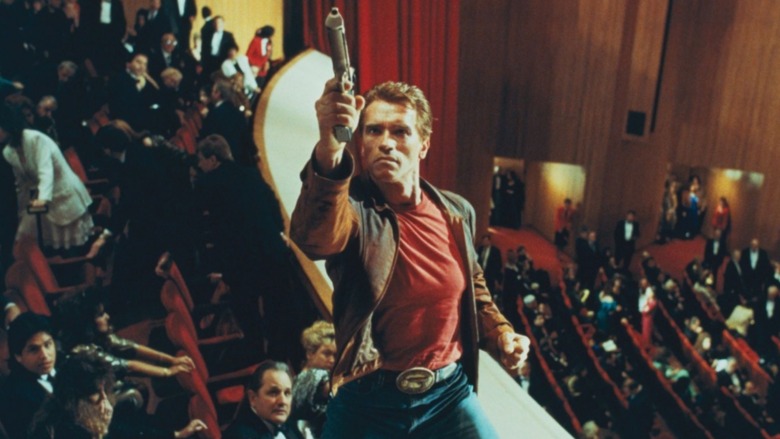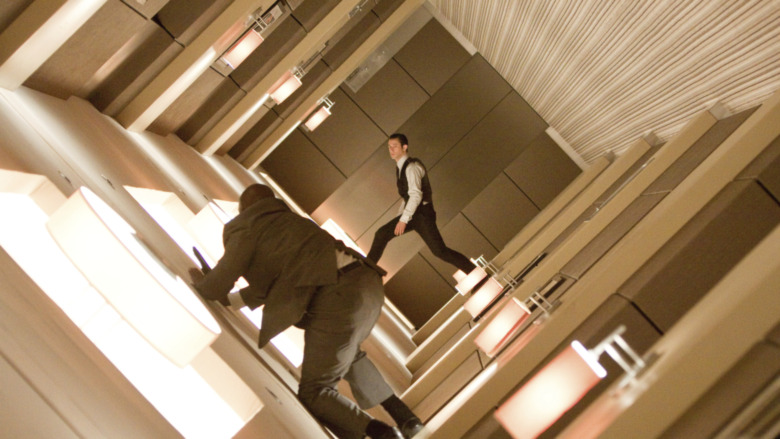13 Movies Like Ready Player One You Need To See
Steven Spielberg's 2018 film Ready Player One offers audiences an all-you-can-eat buffet of pop culture goodness. Based on the best-selling book by Ernest Cline, the movie takes place largely in the OASIS, a virtual reality game world where a person's avatar can look like anything or anyone. Unsurprisingly, this inspires many players to run around as Batman, Freddy Krueger, and even Hello Kitty.
But the movie is more than just the ultimate cosplay festival. Hardly a frame of film goes by without some exciting pop culture reference, from the Back to the Future-style DeLorean driven by main character Wade Watts (Tye Sheridan) to the jaw-dropping (and hair-raising) recreation of classic scenes from The Shining (1980). As the ultimate love letter to TV and movie fandom, the film owes a lot to the science fiction and fantasy movies of yesterday — and plenty of savvy fans likely saw influences from many classic films that offer their own take on virtual reality escapism and fantastical dream worlds. For those of you hungry for more Ready Player One-style fun, here are our picks for the best sci-fi and fantasy films like Spielberg's groundbreaking movie that you need to watch before you die.
The Matrix made virtual reality mainstream
The Wachowskis' iconic movie The Matrix (1999) offered audiences a fresh look at virtual reality. The story of a human resistance battling a machine empire within a virtual construct designed to turn them into controllable energy supplies, The Matrix remains the ultimate video game movie. Audiences loved the idea that Neo (Keanu Reeves) and his companions could give themselves virtual superpowers to fight AI entities like Agent Smith (Hugo Weaving) so much that the film spawned two more films and several animated shorts.
Many fans of Cline's original novel saw influences from The Matrix films: certainly the idea of humans living in a virtual world is a big part of Ready Player One (although the heroes hang out in the OASIS more for fun than survival). Then there's the appeal of seeing Wade and his team go up against an evil corporate antagonist with virtual powers of its own. Still, Spielberg's film emphasizes the whimsical aspects of the OASIS, which makes the movie less tense than The Matrix but amps up the fun factor.
With the Matrix trilogy adding another film to its franchise in 2021, Ready Player One fans could see Wade and his friends make the same move. Cline has already published a sequel to his original novel, Ready Player Two, which can help lay the groundwork for a new franchise.
Willy Wonka & The Chocolate Factory invited you to a fantasy world
The Matrix may have offered Ready Player One its basic template, but in terms of style the movie (and the book) owes a debt to another classic film — 1971's Willy Wonka & The Chocolate Factory. Based on the beloved children's book Charlie and the Chocolate Factory by Roald Dahl, the musical sees impoverished boy Charlie Bucket (Peter Ostrum) inexplicably become one of the lucky recipients of a Golden Ticket which earns him passage through the magical chocolate factory of Willy Wonka (Gene Wilder).
Along with four naughty children, Charlie navigates his way through an impossible dream world full of chocolate waterfalls, flying glass elevators, and psychedelic candy boat rides. Yet there are dangers too, including chewing gum that mutates you into a giant blueberry, soda pop that makes you float uncontrollably, and cameras that can shrink candy bars (and people) to a fraction of their size.
Ready Player One's crazy game master James Halliday bears more than a few things in common with Willy Wonka. Both characters are regarded as god-like masters of their craft who invite people to come play in their magical (and dangerous) fantasy lands. Both are unhinged, isolated geniuses who follow their own agendas. And both offer prizes that the public will go to ridiculous lengths to win.
The Lego Movie celebrated pop culture
Pop culture pastiches have become increasingly popular in cinema — but few are as blatant about this as The Lego Movie (2014). Taking place in a fictional world where Lego characters from the company's 88-year history interact freely, the story follows Emmet (Chris Pratt), a seemingly ordinary Lego figure who abandons his ridiculously conformist society to join a madcap team of free thinkers. Emmet becomes the unwitting hero of an adventure where "Master Builders" can create literally anything out of their world's interchangeable plastic bricks.
A celebration of imagination as well as a nostalgic look back at classic Lego sets, The Lego Movie reminds audiences that there truly are no limits when it comes to creating personal fantasy worlds. Much like Ready Player One, which is full of loving recreations of favorite movies and pop culture stories, The Lego Movie is jam-packed with so many fun references people can't help but discover something new every time they re-watch it.
The story possibilities are so vast that the movie launched a creative franchise with later films like The Lego Batman Movie (2017), The Lego Ninjago Movie (2017), The Lego Movie 2: The Second Part (2019). Considering that the virtual worlds of Ready Player One are just as diverse, there's certainly the possibility that Spielberg's movie could launch a similar franchise.
Jumanji brought viewers inside a game
At the core of Ready Player One is the "Hunt for Halliday's Egg," an immersive multi-player game that forces the characters to complete risky challenges in order to find the prize "Easter Egg" and gain control over the OASIS.
Years earlier, director Joe Johnston used a similar structure in his movie Jumanji (1995). Based on the book by Chris Van Allsburg, the movie follows Alan Parrish (Robin Williams), Sarah Whittle (Bonnie Hunt), Judy Shepherd (Kirsten Dunst), and Peter Shepherd (Bradley Pierce) as they struggle to complete a magical board game. Unfortunately, the players invite disaster as every roll of the dice causes lions, evil monkeys, and even a monsoon to invade their world.
The movie was followed by Zathura: A Space Adventure (2005), also based on one of Van Allsburg's books, which featured the same basic story structure but with an outer space theme. Years later, however, the franchise was reimagined into a more VR-style event with Jumanji: Welcome to the Jungle (2019). Now, the players get sucked into a jungle-themed game world and take on the identities of their avatar characters (allowing Dwayne "The Rock" Johnson to flex his comedic muscles by acting like a nerdy asthmatic teenager). The reboot proved popular and was followed by Jumanji: The Next Level (2019), with a fifth Jumanji film in development.
The Cabin in the Woods was a meta-horror movie
While Ready Player One does have some scary moments (notably during the eerie recreation of The Shining), it's largely a sci-fi adventure film and not a horror movie. However, The Cabin in the Woods (2011) isn't your typical monster movie.
It certainly seems to start off that way, with a group of teenage "slasher victims" arriving at an isolated cabin to spend the weekend. Over time, however, we learn that the teens aren't just being threatened by a single monster — they're the victims in a mysterious ritual that uses multiple horror movie tropes to sacrifice humans and appease an ancient entity. At one point, we see a literal menagerie of past horror icons ready to menace the kids, showing that the film could have gone in any direction and still stayed faithful to its offbeat premise.
As the audience flips back and forth between the victims and the secret society manipulating them, we're treated to a very genre-savvy monster movie that makes us rethink the common purpose behind slasher films. It's an imaginative approach that shows how self-aware both movie producers and audiences are getting about horror movies.
Tron took gaming to a whole new level
If there's one movie that audiences think of as the first "trapped in a video game" movie, its Disney's Tron (1982). Considered ahead of its time, the film sees computer programmer Kevin Flynn (Jeff Bridges) get transported into "The Grid," a digital world where video games are high-tech gladiator matches used to enslave computer programs. Forced to experience how violent things are on the other side of the screen, Flynn teams up with the game world's hero Tron (Bruce Boxleitner) to defeat The Grid's evil Master Control Program (David Warner).
Tron gained a devoted cult following, influencing many later movies and finally gaining a sequel in 2010. Tron: Legacy sees Flynn's son Sam (Garrett Hedlund) journey into a new Grid that contains allies like the enigmatic warrior woman Quorra (Olivia Wilde) and enemies like the unbalanced Clu (Jeff Bridges). Tron's unique world was further fleshed out in the Disney animated series Tron: Uprising, which bridged the gap between the first two films.
Although not as widely embraced as The Matrix or Jumanji, Disney's Tron occupies a respected place in virtual reality stories. As one of the first films to tackle the challenges of presenting a story in an abstract computer world, Tron laid down much of the early groundwork that other VR films built their own epic narratives on. With Tron 3 currently in very early development, perhaps we'll see more of this pioneering franchise?
The Thirteenth Floor is a forgotten gem
A more obscure entry on this list, The Thirteenth Floor (1999) has been largely overshadowed by more commercially successful films like The Matrix. Nevertheless, it's a fascinating movie that explores the whole concept of "dreams within dreams" long before Christopher Nolan's Inception (2010).
When a team of cutting-edge computer programmers invent a virtual reality simulation of 1937 Los Angeles, they find themselves involved in a murder conspiracy that claims the life of their company's owner Hannon Fuller (Armin Mueller-Stahl). As Fuller's protégé Douglas Hall (Craig Bierko) investigates by entering the simulation and taking on the identity of his avatar, he uncovers a disturbing truth when he realizes he is already living in a simulation and being manipulated by an outside controller.
Less flashy than the other films on this list, The Thirteenth Floor focuses instead on the philosophical questions surrounding virtual reality and AI — including the way we tend to treat computer entities as disposable people. It's a fascinating, often unsettling look at VR, and one that's worth watching just for its status as a neo-noir film.
Wreck-It Ralph went behind the scenes in a video arcade
One thing Disney animated movies often do is set their stories in the most unlikely of places. In the case of Wreck-it Ralph (2012), it's the hidden space between multiple arcade games where characters go to relax after a hard day of gameplay.
When Ralph (John C. Reilly), the so-called "bad guy" of a popular game, decides he wants more out of life, he abandons his game in hopes of earning a medal and becoming a hero. Unfortunately, his antics end up destabilizing his own game and threaten the entire arcade, although he also discovers a conspiracy surrounding his new friend Vanellope (Sarah Silverman).
One of the great things about Wreck-It Ralph is how the film pokes fun at video game tropes by having Ralph (who's from the classic era of "Super Mario Bros" type games) wander through more modern first-person rail shooter games like Hero's Duty and wonder how video games got so scary and violent. Since the heroes literally live in the game world, the stakes are actually higher than Ready Player One since you just can't log off and avoid the dangers of the game.
Things get even more extreme in Wreck-It Ralph 2: Ralph Breaks the Internet when Ralph and Vanellope journey into the World Wide Web and encounter modern computer games, sentient advertisements, and even a virtual world based on the Disney website. Could things get any more meta?
The Last Starfighter gamed his way into a space war
Children and teenagers of the 1980s know The Last Starfighter (1984) as a guilty pleasure in "gamer" films. Alex Rogan (Lance Guest) is the highest-scoring player of the arcade game "Starfighter" — an accomplishment that gets him abducted by aliens and recruited into the "Rylan Star League." Turns out the video game is actually a way for aliens to find gifted players who can lead their people to victory against the treacherous "Ko-Dan Empire." Alex ends up making friends with several aliens, while back on Earth an android duplicate of Alex named "Beta" struggles to fool Alex's girlfriend Maggie (Catherine Mary Stewart) and cover for Alex's disappearance.
Oddly enough, Armada, Ernest Cline's follow-up novel to Ready Player One, contains more than a few things in common with The Last Starfighter, including a video game-playing hero whose skills get him recruited to fight in an alien war. Despite the low-budget special effects and cheesy plot (or perhaps because of them) the film gained a devoted fandom and even received an off-Broadway musical adaptation in 2004. Considering this was one of the first movies to validate the skills of gamers, it's not hard to see it as the cinematic ancestor of Ready Player One.
Avatar explored changing one's identity
One of the most enjoyable aspects of Ready Player One is the idea of being able to hide your true self behind a created identity or "avatar." James Cameron's appropriately-named epic film Avatar (2009) also explores this idea, albeit in a very different setting.
Taking place on Pandora, an alien moon populated by the peaceful "Na'vi," the story sees paraplegic ex-Marine Jake Sully (Sam Worthington) regain the use of his legs in an unconventional way: By uploading his consciousness into a genetically-engineered Na'vi body (or "avatar"), he's able to explore Pandora's lush world and befriend its inhabitants. However, Jake's company is intent on destroying Pandora for its resources, leading Jake to turn on his people and join the Na'vi in repelling the human invaders.
While the film's story takes place in the "real world," much of it was produced through motion-capture animation and computer-generated sets, meaning the movie was produced largely in computers (albeit with the full range of performances from live actors). Jake's ability to regain full mobility by living a second life in his avatar also resembles the way characters in Ready Player One can drastically redefine themselves by changing their avatar's age, gender, or physical appearance, showing how close the films are thematically.
Ender's Game made war literally into a game
Like Ready Player One, Ender's Game is based on a best-selling book, but the novel took much longer to get to the big screen. Although sci-fi writer Orson Scott Card wrote the original short story in 1977 (which was expanded into a novel in 1985), it wasn't until 2013 that it got the big budget movie treatment in a film directed by Gavin Hood and featuring Harrison Ford.
The book deals with such timeless themes and contemporary ideas that it's easy for new generations to get immersed in the story. In a war-torn future, humankind has recruited gifted children to command their military fleets against an alien race called the Formics. Among these recruits, Andrew "Ender" Wiggin (Asa Butterfield) is one of the most gifted, thanks to his ability to empathize with his opponents and uncover their weaknesses. Unfortunately, Ender soon learns the video game-style simulations he's running have some very real consequences against an enemy that may not be so malevolent.
Much like The Last Starfighter and Ready Player One, Ender's Game offers a world where the often-trivialized skills of gamers gain massive significance. Unlike these other films, however, Hood's movie takes a darker look at video game culture and explores how viewing war as a game helps dehumanize your opponent.
Last Action Hero poked fun at its own genre
If there's one thing Ready Player One has no shortage of, it's pop culture references. This is also true of Arnold Schwarzenegger's offbeat action-comedy Last Action Hero (1993). While the film earned generally negative reviews upon its initial release, it's now recognized as a fun movie that celebrates and pokes fun at the ridiculous tropes in action films.
Danny Madigan (Austin O'Brien) loves action movies — especially the Jack Slater films starring Arnold Schwarzenegger. But when a magical ticket sucks him into the latest Slater film, Danny comes face-to-face with his hero and must use his knowledge of action movie tropes to survive the constant car chases and explosions. This includes taking advantage of the notions that bad guys talk too much, getting shot only gives you a "flesh wound," and anyone can manipulate complex machinery if the plot calls for it.
Things get more complicated when a movie villain steals the ticket and emerges in the real world, which he discovers is the one place where the bad guy can (and often does) win. Danny and Jack follow him but find that Slater's usual tricks don't work in real life.
Last Action Hero's slapstick approach to action sequences offers plenty of laughs, although its 131-minute runtime does feel a bit bloated. Even so, there's plenty to love about the parody, which features cameos from classic action movie stars Robert Patrick (Terminator 2), Sylvester Stallone, and even Jean-Claude Van Damme.
Inception blurred the line between reality and dream
Most of the films on this list emphasize using advanced technology to create virtual worlds. However, as Christopher Nolan's unconventional heist film Inception shows, the best fictional worlds still exist within your mind. Flipping many conventional ideas of heist dramas on their heads, the story follows Cobb (Leonardo DiCaprio), a professional thief who leads a crew of mind hackers into other people's dreams to steal their secrets.
When a powerful businessman (Ken Watanabe) recruits Cobb to sabotage a rival business, Cobb's team must construct multiple dream worlds to insert a pivotal idea deep in their mark's subconscious. In the process, we learn many disturbing truths about Cobb's dangerous experiments with lucid dreaming and start questioning the very nature of reality itself.
Highly cerebral, the movie offers plenty of brain bending imagery and impossible action sequences that could only take place in a dream. Ready Player One might stretch the boundaries of imagination, but Inception and many other sci-fi and fantasy films regularly prove that those boundaries can be stretched even further.
